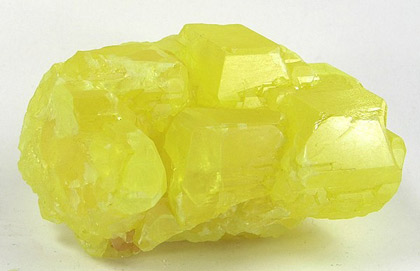|
Home
Sulphur and its Properties
Sulphur, which is also spelt sulfur, is a chemical
element with symbol S and atomic number of 16. It is a non-metal and is readily
available at room temperature as a bright yellow crystalline solid.

Sulphur. Image source:
Realfoods.co.uk
Sources of Sulphur
Sulphur can be found from the following sources:
(1). Extraction from beneath the earth crust - this is the most important source.
(2). From natural gas - this is the second most important source. The natural gas is found in southern
France, in a place called Lacq.
(3). From other processes - example, as a by-product of the purification of crude coal gas and the refining of petroleum.
Properties of Sulphur
Sulphur shows the following properties:
Physical Properties
(1). Sulphur is a yellow solid and is insoluble in water but soluble in carbon
disulphide and toluene (methyl
benzene).
(2). Sulphur is a non-metal and therefore a poor conductor of heat and electricity.
(3). The boiling point of sulphur is 444oC. When sulphur vapour is condensed, a fine powder, which forms a floral pattern is obtained - this is called ‘flower of
sulphur.
Chemical Properties
(1). Most metals and non-metals combine directly with sulphur.
Example: in the absence of air, sulphur combines directly with most metals to form suphides when heated
Fe(s) + S(s) → FeS(s)
Zn(s) + S(s) → ZnS(s)
Pb(s) + S(s) → PbS(s)
2Cu(s) + S(s)
→ Cu2S(s)
Note: the reactive elements, like Na and K may react with sulphur spontaneously (without heating)
(2). Sulphur burns in excess of air with a bright blue flame, to form sulphur(IV) oxide and a little quantity of sulphur(VI) oxide.
O2(g) + S(s) → SO2(g)
(3). Sulphur combines slowly at high temperature with hydrogen, to form hydrogen sulphide.
H2(g) + S(s) → H2S(g)
(4). Suphur vapour combines with hot coke to form a liquid - carbon disulphide.
C(s) + S(g) → CS2(l)
(5). Action of oxidizing acids on sulphur
Note:
* With hot concentrated H2SO4, suphur is oxidized to suphur(IV) oxide, SO2, while the acid is reduced to SO2.
2H2SO4(aq) + S(s)
→ 2H2O(l) + 3SO2(g)
* With hot conc. HNO3 using bromine as catalyst, sulphur is oxidized to tetraoxosulphate(VI) acid.
6HNO3(aq) + S(s) → H2SO4(aq) + 6NO2(g) + 2H2O(l)
* With dilute acids and with conc. HCl - no reaction with sulphur.
(6). Action of hot concentrated alkalis.
With hot conc. alkalis, sulphur forms a mixture of sulphides and sulphate(IV). Polysulphide and thiosulphate(VI) are formed in the presence of excess sulphur.
3S + 6OH- → 2S2- + SO32- + 3H2O
With excess sulphur, SO32- + S
→ S2O32- (thiosulphate(VI))
Allotropes of Sulphur
Sulphur exists in different forms (in the same physical state). There are two important crystalline forms - rhombic or octahedral (α - sulphur), and monoclinic sulphur (β - sulphur).
Note: one important difference between these two forms of crystalline sulphur is temperature.
Rhombic sulphur crystallizes at temperature below 96oC, while monoclinic sulphur crystallizes at temperature above 96oC.
The temperature, 96oC is called the transitional temperature between the two forms.
The table below gives a summary of the differences between the two forms of sulphur:
Another allotrope of sulphur is polymeric sulphur(s8). It is an eight member ring molecule. At temperature of 160oC or higher, the sulphur molecule is energized and
eventually ruptures.
It is insoluble in organic media, natural and synthetic rubber, as well as in carbondisulphide.
An evidence of the above being allotropes is that each one can be converted to the other without a change in mass. If equal masses of the allotropes are converted into a given compound, example, H2S, the same masses of products are obtained.
Below is a summary of the properties of both rhombic
and monoclinic sulphur
Rhombic Sulphur
1. Yellow, translucent crystals.
2. Density of 2.08 gcm3.
3. Melting point of 114oC.
4. Stable at temperatures below 96oC.
Monoclinic Sulpur
1. Transparent, amber crystals.
2. Density of 1.98gcm3.
3. Melting point of 119oC.
4. Unstable at temperatures below 96oC, reverting to rhombic form.
Uses of Sulphur
The following are some of the ways sulphur is used:
(1). To prevent the growth of certain kinds of fungus in vines.
(2). To manufacture tetraoxosulphate(VI) acid - this is the most
important use of sulphur.
(3). To manufacture calcium hydrogen trioxosulphate(IV), Ca(HSO3)2 - this is used as a bleacher of wood pulp in the making of paper.
(4). To vulcanize rubber, that is, to make rubber hard and tough by binding rubber molecules together.
(5). In the manufacture of dyes.
(6). In the manufacture of sulphur compounds, such as carbon disulphide, CS2 and sulphur monochloride, S2Cl2 - a solvent for rubber,
which is also used in the vulcanization of rubber.
(7). Used as medicinal ointments.
(8). As sulphide, example phosphorus sulphide,
which is used in making fireworks, matches and gun powder.
|